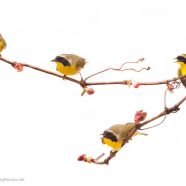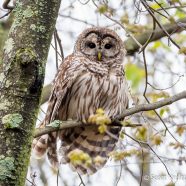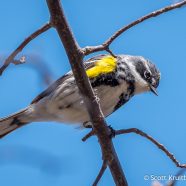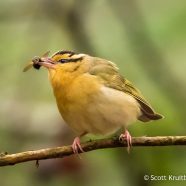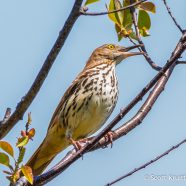Common Yellowthroat (Geothlypis trichas)
Some of our more common breeding songbirds have returned to the Northeast and are already setting up territories. The Common Yellowthroat (Geothlypis trichas) is one such species, and RTPI Affiliate Sean Graesser captured the character of an adult male in this wonderful piece for his Audubon series. Photographed for the Meet Your Neighbours global biodiversity project in Connecticut while on assignment for The Roger Tory Peterson Institute of Natural History.
Read MoreBarred Owl (Strix varia)
This Barred Owl (Strix varia) saw me long before I saw it, monitoring my movements from afar while perched in this tree on a cloudy May morning. Those enormous dark eyes tracked me in a relaxed fashion as I was still rather far away when I noticed it. I had been watching several warblers and a Blue-gray Gnatcatcher before my eyes stumbled on this slightly larger species. Barred Owls are, of course, usually snoozing during the day, but not always – and the spring season is when I have seen them the most active diurnally. This bird did not wake up because I was there, nor was it sleepy....
Read MoreYellow-rumped Warbler
Here are a couple more stunning Yellow-rumped Warbler photos while they are looking so fantastic in their spring shades – and right before all the leaves pop out. They’ll be heading out soon as a greater diversity of warblers arrive in our backyards. I did see one unique Yellow-rumped Warbler yesterday that I will feature in an upcoming post… Scott Kruitbosch Conservation & Outreach Coordinator
Read MoreWorm-eating Warbler (Helmitheros vermivorum)
I was thrilled to find and then get great views of this Worm-eating Warbler (Helmitheros vermivorum) singing and feeding earlier today. I first heard its insect-like trill of a song from along a steep, rocky slope in the forest featuring a lot of vegetation in the understory – precisely what they want for the breeding season. We in the Northeast are at the northern edge of their range, and finding the uncommon birds can be difficult. Worm-eating Warbler populations are said to be stable, but they certainly do decline and increase in certain regions depending on local conditions....
Read MoreBrown Thrasher Singing
This Brown Thrasher (Toxostoma rufum) was another recent sighting of mine. It may be in a suitable nesting location – a blueberry patch – and was singing away from multiple perches. Another bird was nearby, and both were active and remaining in the same area. This does not necessarily mean they will make a nest here, but for now it is possible and perhaps probable. Look at that eye… Scott Kruitbosch Conservation & Outreach Coordinator
Read More



